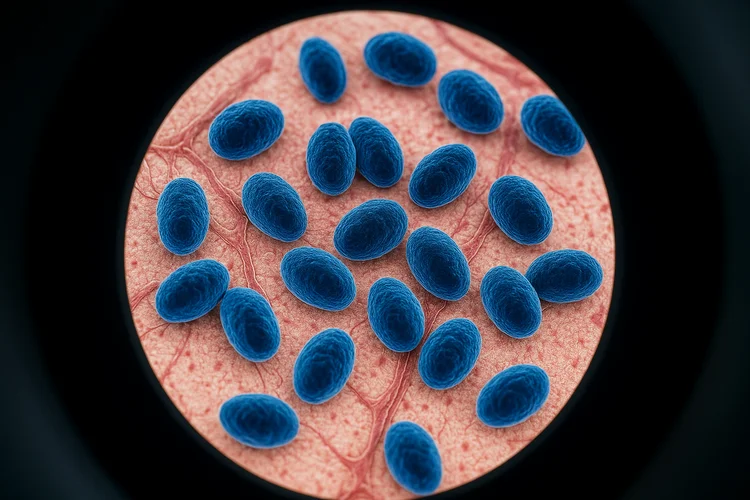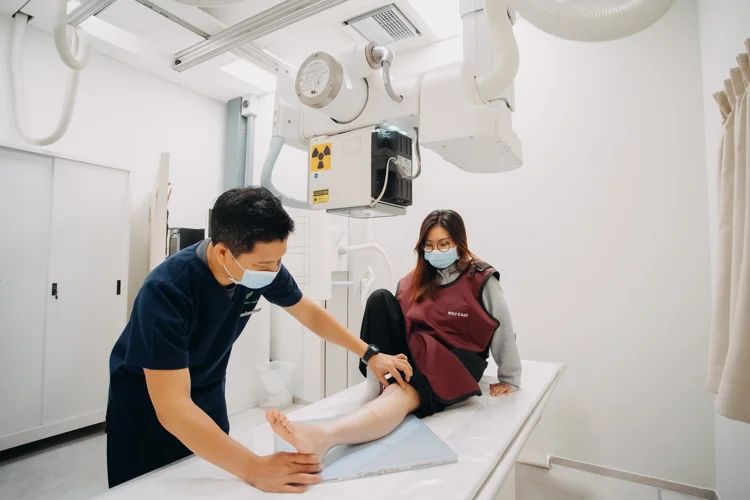Ureaplasma: Symptoms, Diagnosis, and Treatment
What Is Ureaplasma?
Ureaplasma is a type of bacteria that naturally lives in the urinary and reproductive tracts of
men and women but may cause infections when present in large numbers or when it spreads
to other parts of the body. Unlike most bacteria, ureaplasma lacks a cell wall,
making it resistant to certain antibiotics that target bacterial cell walls.
These bacteria belong to the Mycoplasmataceae family and are mainly represented by two
species: Ureaplasma urealyticum and Ureaplasma parvum. Many individuals carry
ureaplasma harmlessly without any symptoms. However, in some cases, it can
contribute to conditions affecting fertility, the urinary tract, or the reproductive organs.

How Is Ureaplasma Transmitted?
Ureaplasma spreads primarily through sexual contact, including vaginal, oral, and anal
sex. Because most infections do not cause noticeable symptoms, individuals may unknowingly
transmit the bacteria to their partners.
While not formally classified as a sexually transmitted infection (STI),
its mode of transmission closely mirrors that of common STIs, and it often coexists with them.
Transmission from mother to infant during childbirth is also
possible, which is why detection and management during pregnancy may be advised in some situations.
What Are Symptoms of a Ureaplasma Infection?
Most people with a ureaplasma infection do not exhibit symptoms. When symptoms do occur, they are typically related to inflammation in the urinary or genital tract. Common signs and symptoms may include:
- Pain, stinging, or burning when urinating (dysuria)
- Vaginal or penile discharge that is unusual in colour or consistency
- Itching or irritation in the genital area
- Discomfort during sexual intercourse (dyspareunia)
- Persistent pelvic or lower abdominal pain

Because these symptoms overlap with other infections, proper medical evaluation and testing are necessary for accurate diagnosis and treatment.
What Are the Risks of Untreated Ureaplasma Infection?
Leaving a ureaplasma infection untreated can, in certain cases, result in complications, especially in
individuals who have existing health risks or concurrent infections.
Potential complications may include:
- In women – bacterial vaginosis, cervicitis, inflammation of the uterus (endometritis), and pregnancy-related issues such as premature labour, chorioamnionitis, or infections in newborns
- In men – persistent urethritis not caused by gonorrhoea, or inflammation of the prostate (prostatitis)
- Reduced fertility, such as lower sperm motility or challenges conceiving
Although carrying ureaplasma does not always mean there is a medical problem, treatment should be considered when it is linked to symptoms or health complications.
How Is a Ureaplasma Infection Diagnosed?
Ureaplasma is typically diagnosed through laboratory testing of swabs or urine
samples. Swabs may be collected from the cervix, vagina, or urethra, depending on
the individual’s symptoms and gender.
Because ureaplasma lacks a cell wall, it cannot be detected using standard bacterial cultures,
so specialised testing is required.
Common diagnostic methods include:
- PCR (Polymerase Chain Reaction) Test – Detects the bacteria’s genetic material (DNA) and is the most sensitive and widely used method.
- Culture Test – Involves growing the bacteria in a laboratory to confirm its presence.
- Comprehensive STI Panels – Broader tests that check for multiple infections, including Ureaplasma and other sexually transmitted pathogens.

When Is Ureaplasma Treatment Recommended?
Treatment for ureaplasma is usually recommended when it causes symptoms, recurs frequently, or
is associated with fertility issues, pregnancy complications, or other infections.
Since the bacteria lack a cell wall, antibiotics that work by targeting cell wall synthesis are
ineffective. Instead, treatment typically involves antibiotics such as doxycycline, azithromycin, or erythromycin, which act through different mechanisms to eliminate
the infection.
The duration and dosage depend on the individual’s condition and medical history. In some cases,
follow-up testing may be recommended to confirm that the infection has completely resolved.
What Is the Cost of Ureaplasma Testing & Treatment?
At healthscreening.sg, we offer discreet testing and treatment for ureaplasma infections, with the prices as follows:
| Test / Treatment | Test Type | Prices* |
|---|---|---|
| Consultation | From $49.05 | |
| Testing | ||
| Urogenital Mycoplasma and Ureaplasma Culture | Swab | $76.30 |
|
Enhanced Female Genital Screen (9 tests) Chlamydia, Gonorrhoea, Mycoplasma genitalium, Mycoplasma hominis, Trichomonas, Ureaplasma parvum, Ureaplasma urealyticum, Candida, Gardnerella Vaginosis |
Swab | $348 |
|
Complete Female STD Screen (15 tests) HIV, Syphilis, Hepatitis B, Hepatitis C, Herpes Simplex Virus 1 and 2, Chlamydia, Gonorrhoea, Mycoplasma genitalium, Mycoplasma hominis, Trichomonas, Ureaplasma parvum, Ureaplasma urealyticum, Candida, Gardnerella Vaginosis |
Blood + Swab | $478 |
|
Male Genital Screen (8 tests) Chlamydia, Gonorrhoea, Mycoplasma genitalium, Mycoplasma hominis, Trichomonas, Ureaplasma parvum, Ureaplasma urealyticum, Monilia |
Urine | $318 |
|
Complete Male STD Screen (14 tests) HIV, Syphilis, Hepatitis B, Hepatitis C, Herpes Simplex Virus 1 and 2, Chlamydia, Gonorrhoea, Mycoplasma genitalium, Mycoplasma hominis, Trichomonas, Ureaplasma parvum, Ureaplasma urealyticum, Monilia |
Blood + Urine | $428 |
|
Enhanced Genital Ulcer Testing (18 tests) HIV, Syphilis (swab + blood test), Hepatitis B, Hepatitis C, Chlamydia, Gonorrhoea, Mycoplasma genitalium, Mycoplasma hominis, Trichomonas, Ureaplasma parvum, Ureaplasma urealyticum, Herpes Simplex Virus 1 and 2, Haemophilus Ducreyi (Chancroid), Cytomegalovirus, Lymphogranuloma, Venereum, Treponema Pallidum (Syphilis), Varicella Zoster Virus |
Blood + Swab | $538 |
| Treatment | ||
| Oral Antibiotics | From $1.09 per tab | |
*Prices are NETT and inclusive of GST.
We provide confidential testing and treatment
for STIs, available either as individual tests or as part of comprehensive screening packages.
For your comfort and preference, you may request to see a male or female doctor, subject to
availability.
For more information about available tests or to make an appointment, please contact us
directly.
How Can Ureaplasma Infection Be Prevented?
Although ureaplasma can exist harmlessly in many healthy individuals, several preventive steps can help minimise the risk of infection or transmission:
- Use condoms consistently and correctly during sexual activity
- Have regular STI screenings if you are sexually active or have new partners
- Seek medical care promptly for genital discomfort, discharge, or other symptoms
- Discuss sexual health openly with your partner(s)
When planning a pregnancy or undergoing fertility evaluations, both partners may be recommended to have screening and, if ureaplasma is found, receive treatment to reduce the risk of complications.
What Should You Do If You Suspect a Ureaplasma Infection?
If you suspect a ureaplasma infection, it’s important to get tested since its symptoms can resemble those of other conditions. You should see a doctor if:
- You feel pain or a burning sensation when urinating
- You notice unusual vaginal or penile discharge
- You experience pelvic or lower abdominal discomfort
- You may have been exposed through unprotected sexual contact
- Your symptoms persist or keep returning after previous treatment
Timely assessment helps ensure proper diagnosis and effective treatment, reducing the risk of ongoing or recurrent infection.
How to Book an Appointment for Ureaplasma Testing?
Why Choose Us?








Navigate Easy With Google Maps
Health Screening Singapore
(Anson House)
Health Screening Singapore
(Camden Medical Centre)
Frequently Asked Questions (FAQ)
Ureaplasma is mainly transmitted through sexual contact, including vaginal, oral, or anal intercourse. Because many people with the bacteria have no symptoms, it can easily be passed to partners without their knowledge. Less commonly, it may be transmitted from mother to baby during childbirth. If you suspect exposure or experience symptoms such as genital discomfort or discharge, it is advisable to consult a doctor for testing.
Ureaplasma is often harmless and part of the body’s normal genital flora, but in some people, it can cause inflammation or contribute to infections. If left untreated, it may occasionally lead to complications such as urethritis, pelvic infections, reduced fertility, or pregnancy-related issues. The degree of harm depends on the individual’s health, coexisting infections, and bacterial load. If you are experiencing symptoms such as genital discomfort, discharge, or pain when urinating, it is advisable to seek medical evaluation.
Ureaplasma infection is not the same as a urinary tract infection, although both can cause similar symptoms like pain during urination. UTIs are usually caused by bacteria such as E. coli, while ureaplasma is a distinct microorganism that lacks a cell wall and requires specialised testing for detection. If you have persistent urinary symptoms, it is best to consult a doctor for a proper diagnosis.
Ureaplasma is not formally classified as a sexually transmitted disease (STD), but it behaves like one since it spreads mainly through sexual contact and often coexists with other STDs. Many individuals carry the bacteria without symptoms, so testing may be advised if you have unprotected sex or recurrent genital issues such as discharge, irritation, or pelvic discomfort.
In some individuals, ureaplasma bacteria may naturally decrease or clear without treatment, especially when it does not cause symptoms or infection. However, if it leads to discomfort, active infection, or fertility problems, antibiotics are usually required. Follow-up testing may be recommended to confirm that the bacteria have been fully cleared.
Discharge caused by ureaplasma infection can vary but is often clear, whitish, or slightly yellow. It may also be accompanied by an unusual odour or discomfort during urination or intercourse. Because discharge can result from various infections, including other STIs, laboratory testing is necessary to confirm the cause. You should see a doctor if you notice any persistent or abnormal discharge.
Ureaplasma infection can be mistaken for other genital or urinary tract infections such as chlamydia, gonorrhoea, bacterial vaginosis, or non-gonococcal urethritis because the symptoms, including discharge, burning during urination, or pelvic discomfort, often overlap. Only laboratory testing can accurately identify ureaplasma. If you have symptoms suggestive of infection, it is advisable to consult a doctor for appropriate testing and diagnosis.
Ureaplasma and bacterial vaginosis (BV) are different conditions, though they may occur together. BV is caused by an imbalance of vaginal bacteria, while ureaplasma is a specific microorganism that can live in the genital tract. Both can cause abnormal discharge and discomfort, so testing helps distinguish between them and ensures proper treatment. If you notice such symptoms, it is advisable to see a doctor for assessment.
Ureaplasma does not cause human papillomavirus (HPV), as the two are entirely different infections. HPV is a viral infection transmitted through sexual contact, while ureaplasma is bacterial. However, both can coexist, particularly in sexually active individuals. Detecting and managing ureaplasma and other infections early may help reduce the risk of complications. If you are concerned about HPV or other STIs, it is best to consult a doctor for screening.
Yes, ureaplasma is common, and many healthy individuals naturally carry it without symptoms or complications. It forms part of the normal genital flora in both men and women but may cause infection when it multiplies excessively or spreads. If you develop symptoms such as genital discomfort, discharge, or pain during urination, or suspect an infection, it is advisable to seek medical evaluation.
Chlamydia and ureaplasma are not the same. Chlamydia is caused by Chlamydia trachomatis, while ureaplasma is a different type of bacteria from the Mycoplasmataceae family. Both can cause similar symptoms such as burning during urination or genital discharge, but they require different tests and antibiotics. If left untreated, either infection can sometimes lead to complications such as pelvic inflammation, infertility, or pregnancy-related issues.
Ureaplasma is most commonly acquired through sexual contact, though it can also be present naturally in the genital tract without being transmitted. Because many carriers have no symptoms, you may have contracted it unknowingly. Transmission from mother to baby can also occur during childbirth. If you have symptoms or concerns about possible exposure, it is advisable to seek medical testing for confirmation.
Discharge from a ureaplasma infection may appear clear, whitish, or slightly yellow and can vary in consistency. It may also be accompanied by an unusual odour, irritation, or discomfort during urination or intercourse. Since similar discharge can occur with other infections, only a laboratory test can confirm the cause. If you notice persistent or abnormal discharge, you should consult a doctor for evaluation.
Metronidazole is generally not used to treat ureaplasma because it targets anaerobic bacteria and parasites rather than ureaplasma species, which lack a cell wall. Antibiotics such as doxycycline or azithromycin are more commonly prescribed. If you have been diagnosed with ureaplasma or are unsure about your treatment, it is best to follow your doctor’s advice for appropriate medication.
